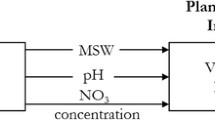Abstract
Changes in vegetation are often caused by changes in abiotic site factors, such as pH, nitrogen availability and soil moisture. It has been recognized that abiotic site factors are affected by atmospheric deposition and groundwater-table changes. In order to evaluate the effects of eutrophication, acidification and desiccation on site factors, the model SMART2 has been developed. For the Netherlands combinations of two acidification and two seepage scenarios (1990–2050) were evaluated with SMART2. The results are focused on pH, nitrogen availability and base saturation. Calculations were made for combinations of five vegetation structures on seven soil types and the five groundwater-table classes, using a 1 km2 grid. Results showed that deposition reductions lead to a relatively fast improvement of the site factors, increase in pH and base saturation and decrease in N availability. Whereas a reduction in groundwater abstractions of 25% has little or no effect on the pH and N availability.
Similar content being viewed by others
References
Anonymous: 1985, De Nederlandse Bosstatistiek. Deel 1 De oppervlakte bos van 1980 to 1983, Den Haag, Centraal Bureau voor de Statistiek, Staatsdrukkerij.
De Vries, W., M. Posch and J. Kämäri: 1989, ‘Simulation of the long-term soil response to acid deposition in various buffer ranges’, Water, Air and Soil Pollut. 48, 349–390.
Ellenberg, H., H.E. Weber, R. Dull, V. Wirth, W. Werner and D. Paulissen: 1991, Indicator values of plants in Central Europe, Erich Goltze, Göttingen.
Erisman, J.W.: 1991, Acid deposition in the Netherlands, Bilthoven, RIVM Report nr. 723001002.
Kros, J., Reinds, G.J., De Vries, W., Latour, J.B. and Bollen, M.: 1995, Modelling of soil acidity and nitrogen availability in natural ecosystems in response to changes in acid deposition and hydrology, Wageningen, SC-DLO Report 95.
Latour, J.B. and R. Reiling: 1993, ‘MOVE: a multiple-stress model for vegetation’, Sci. Tot. Environ. Supplement, 1513–1526.
Latour, J.B., Reiling, R. and Slooff, W.: 1994, ‘Ecological standards for eutrophication and desiccation: perspectives for risk assessment’, Water, Air and Soil Pollut. 78, 265–277.
Loopstra, I.L. and Van der Maarel, E.: 1984, Toetsing van de ecologische soortengroepen in de Nederlandse flora aan het systeem van indicatiewaarden volgens Ellenberg, De Dorschkamp, Wageningen, report no. 381.
Pastoors, M.J.H., 1993, Landelijk grondwater model; conceptuele modelbeschrijving — Onderzoek effecten grondwaterwinning 10, Bilthoven, RIVM report 714305004.
Thunnissen, H.A.M., Olthof, R., Getz, P. and Vels, L.: 1992, Grondgebruiksdatabank van Nederland vervaardigd met behulp van Landsat Thematic Mapper opnamen, Wageningen, SC-DLO rapport 168.
Wiertz, J., Van Dijk, J. and Latour, J.B.: 1992, De MOVE-vegetatie module: De kans op voorkomen van 700 plantesoorten als functie van vocht, pH, nutrienten en zout., IBN-DLO/RIVM, Wageningen/Bilthoven, report no. IBN 92/24; RIVM 711901006.
Author information
Authors and Affiliations
Rights and permissions
About this article
Cite this article
Kros, J., Reinds, G.J., De Vries, W. et al. Modelling the response of terrestrial ecosystems to acidification and desiccation scenarios. Water Air Soil Pollut 85, 1101–1106 (1995). https://doi.org/10.1007/BF00477128
Issue Date:
DOI: https://doi.org/10.1007/BF00477128




